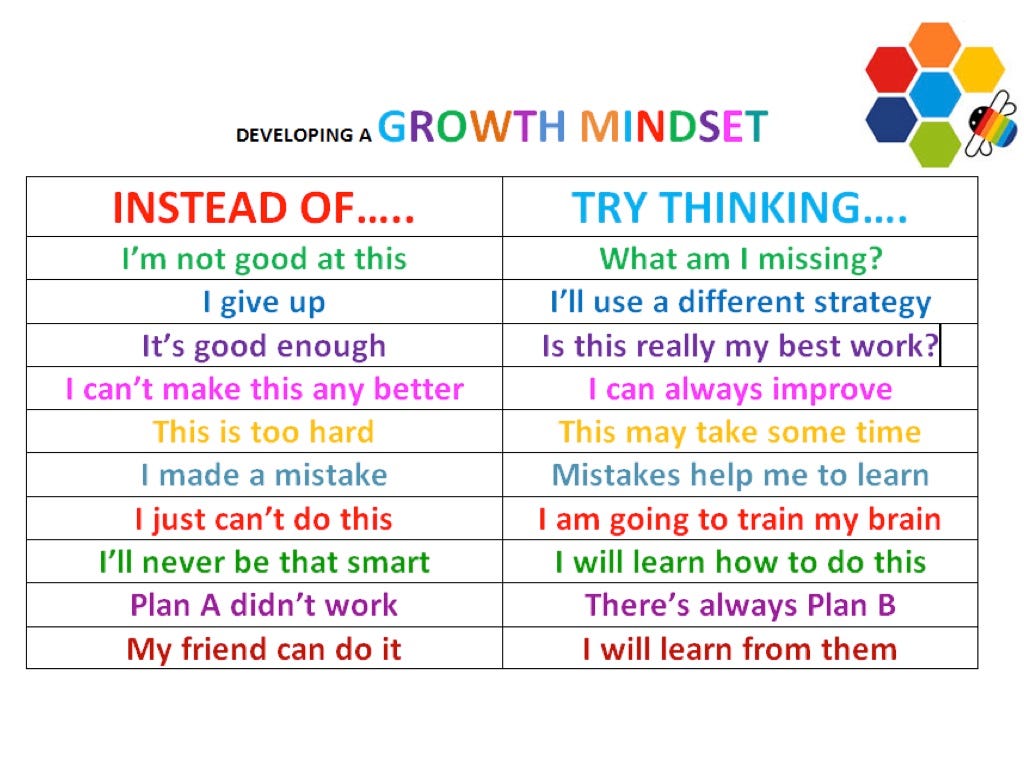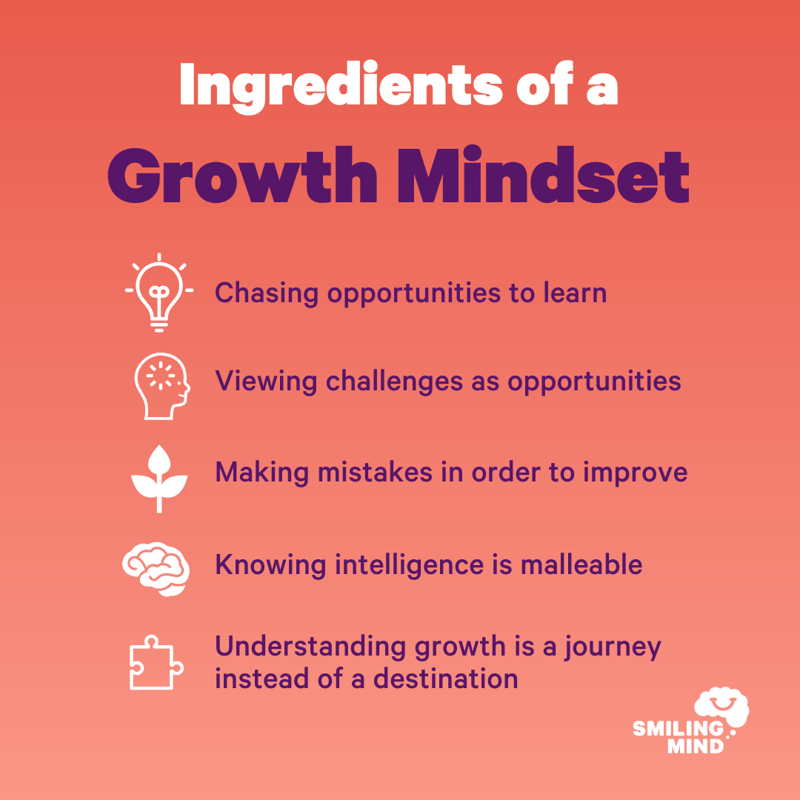To develop a growth mindset, embrace challenges and view failures as opportunities to learn. Cultivate a love for learning and persistence.
A growth mindset is essential for personal and professional development. It involves believing that abilities and intelligence can be developed through hard work, dedication, and learning from mistakes. This mindset contrasts with a fixed mindset, where individuals believe their abilities are static and unchangeable.
Adopting a growth mindset encourages resilience, adaptability, and continuous improvement. It helps individuals tackle obstacles with confidence and a positive attitude. By fostering a growth mindset, one can unlock potential, achieve greater success, and lead a more fulfilling life. Start by challenging yourself, seeking feedback, and embracing the journey of lifelong learning.

Credit: www.growthmindsetatwork.com
Introduction To Growth Mindset
Developing a growth mindset can transform your life. It helps you learn and grow continuously. Understanding this mindset is crucial for personal and professional success.
What Is A Growth Mindset?
A growth mindset believes that abilities can improve with effort. People with this mindset embrace challenges. They see failures as opportunities to learn. They are always eager to try new things. A growth mindset contrasts with a fixed mindset. In a fixed mindset, people think abilities are static. They avoid challenges and fear failure.
Importance Of A Growth Mindset
Having a growth mindset is vital for success. It encourages resilience and perseverance. People with a growth mindset are more likely to achieve their goals. They handle setbacks better and learn from them. This mindset fosters a love for learning and self-improvement.
Here are some key benefits of a growth mindset:
- Increased Resilience: Bounce back from failures quickly.
- Continuous Learning: Always seek new knowledge.
- Better Problem-Solving: Approach issues creatively.
- Improved Relationships: Engage positively with others.
Adopting a growth mindset opens doors to endless possibilities. It helps you become a better version of yourself.
Fixed Mindset Vs Growth Mindset
Understanding the difference between a fixed mindset and a growth mindset is crucial. A fixed mindset believes talents are static. A growth mindset believes skills can be developed. Your mindset can affect your success and happiness.
Characteristics Of A Fixed Mindset
| Fixed Mindset | Description |
|---|---|
| Belief in Static Intelligence | People believe their intelligence is fixed. |
| Avoid Challenges | They shy away from challenges. |
| Give Up Easily | They give up when faced with obstacles. |
| Ignore Feedback | They see feedback as personal criticism. |
| Feel Threatened by Others’ Success | They feel envious of successful people. |
Traits Of A Growth Mindset
- Belief in Development: People believe they can grow and improve.
- Embrace Challenges: They see challenges as opportunities.
- Persistence: They keep trying despite obstacles.
- Learn from Criticism: They see feedback as a way to learn.
- Inspired by Others’ Success: They are inspired by successful people.
Adopting a growth mindset can transform your life. It encourages learning, resilience, and continuous improvement. Start by changing small habits and thoughts.
Benefits Of A Growth Mindset
Developing a growth mindset offers many benefits. It leads to continuous self-improvement and success in various life aspects. Below, we explore the significant benefits under the headings of Personal Development and Professional Success.
Personal Development
A growth mindset helps in personal development. It encourages you to embrace challenges and persist in the face of setbacks. This mindset fosters a love for learning and resilience. You become better at handling stress and anxiety.
- Embracing Challenges: You see challenges as opportunities to grow.
- Resilience: You recover quickly from failures and setbacks.
- Love for Learning: You enjoy the process of learning new things.
| Aspect | Benefit |
|---|---|
| Stress Management | Better handling of stress and anxiety |
| Self-Awareness | Increased understanding of your strengths and weaknesses |
Professional Success
A growth mindset is also crucial for professional success. It drives you to seek improvement and innovation. You are more likely to succeed in your career if you have a growth mindset.
- Continuous Improvement: You always look for ways to improve.
- Innovation: You are open to new ideas and methods.
- Career Success: You achieve higher levels of success in your job.
- Set specific, achievable goals.
- Seek feedback and act on it.
- Stay committed to your growth journey.
Steps To Cultivate A Growth Mindset
Developing a growth mindset is essential for personal and professional success. It involves believing in your ability to learn and improve. Here are some actionable steps to help you cultivate a growth mindset.
Embrace Challenges
Challenges are opportunities to grow. When you face a difficult task, see it as a chance to learn. This mindset shift can make hard tasks less scary. Remember, every challenge is a step towards improvement.
- Set small, achievable goals to tackle big challenges.
- Celebrate small wins to stay motivated.
- Stay persistent, even when things get tough.
Learn From Criticism
Feedback helps you improve. Instead of seeing criticism as negative, view it as useful information. This can help you identify areas for improvement and grow.
- Listen to feedback with an open mind.
- Ask for specific examples to understand better.
- Implement changes based on the feedback received.
Incorporate these steps into your daily routine to foster a growth mindset. Embrace challenges and learn from criticism to unlock your true potential.
Overcoming Obstacles
Overcoming obstacles is a key part of developing a growth mindset. Challenges and setbacks are inevitable. How you handle these moments can shape your mindset. This section will guide you through dealing with failure and building resilience.
Dealing With Failure
Failure is a part of learning. Everyone faces it at some point. The important thing is how you respond to it. Here are some ways to deal with failure:
- Accept failure as a learning opportunity: Understand that failure is not the end. It’s a chance to learn and grow.
- Analyze what went wrong: Take time to reflect on your mistakes. Identify areas for improvement.
- Seek feedback: Ask for constructive criticism. It can provide valuable insights for future success.
- Stay positive: Maintain an optimistic outlook. Focus on what you can do better next time.
Building Resilience
Resilience is the ability to bounce back from setbacks. Building resilience is crucial for a growth mindset. Here are some tips to help you become more resilient:
- Develop a support network: Surround yourself with positive and supportive people. They can offer encouragement during tough times.
- Practice self-care: Take care of your physical and mental health. Exercise, eat well, and get enough sleep.
- Set realistic goals: Break down big goals into smaller, achievable tasks. Celebrate small wins along the way.
- Stay flexible: Be open to change and adapt to new situations. Flexibility can help you navigate challenges more easily.
Building resilience and dealing with failure are essential for overcoming obstacles. These skills will help you develop a growth mindset and achieve your goals.

Credit: www.makemebetter.net
Role Of Positive Thinking
Developing a growth mindset starts with positive thinking. It helps you see challenges as opportunities. Positive thinking can transform your approach to learning and growth.
Power Of Affirmations
Affirmations are powerful tools. They can reshape your brain’s thought patterns. By repeating positive statements, you can build confidence. Say things like “I can learn anything” or “I improve every day”.
- Boosts self-confidence
- Reduces stress
- Encourages persistence
Visualizing Success
Visualizing success means imagining yourself achieving your goals. This technique helps you feel more prepared. Close your eyes and picture yourself succeeding. This can make your goals feel more attainable.
You can use a simple process:
- Find a quiet space
- Close your eyes
- Picture your success
- Feel the emotions of achieving it
Consistent practice of visualization can boost your confidence and focus.
Influence Of Environment
Developing a growth mindset is crucial for personal and professional success. One key factor is the influence of environment. The environment shapes your mindset, beliefs, and behaviors.
Supportive Communities
Being part of a supportive community boosts your growth mindset. These communities provide encouragement, advice, and constructive feedback. They create a safe space for learning and growth.
Choose communities that challenge you to think differently. Engage with members who inspire and motivate you. Share your experiences and learn from others.
Positive Role Models
Positive role models are essential for developing a growth mindset. They demonstrate resilience, hard work, and perseverance. They show how to overcome challenges and achieve goals.
Identify role models who:
- Inspire you
- Have achieved what you aspire to
- Exhibit qualities you admire
Learn from their experiences and adopt their strategies. Follow their advice and emulate their behaviors. Positive role models can be found in various places:
- Books and articles
- Social media
- Mentorship programs
Surround yourself with people who uplift and encourage you. This will significantly impact your growth mindset.

Credit: medium.com
Continuous Learning
Continuous learning is key to developing a growth mindset. It involves always seeking new knowledge and skills. This helps you adapt and grow in any situation. Below, we explore how lifelong education and adapting to change contribute to continuous learning.
Lifelong Education
Lifelong education means learning does not stop after school. Always look for opportunities to learn new things.
- Read books on different subjects.
- Take online courses.
- Attend workshops and seminars.
Education helps you stay informed and relevant. It also keeps your brain active and sharp.
Learning new skills can boost your confidence. It makes you more adaptable to changes.
Adapting To Change
Adapting to change is another key part of continuous learning. Change is constant in life. Learning to adapt helps you handle new situations better.
- Stay open to new ideas.
- Be flexible in your approach.
- Embrace challenges as learning opportunities.
Being adaptable means you can thrive in any environment. It also makes you more resilient.
Keep learning and stay curious. This will help you develop a strong growth mindset.
Practical Exercises
Developing a growth mindset involves consistent practice. Engaging in practical exercises can make a difference. These activities help to transform your thinking patterns.
Journaling Progress
Journaling is a powerful tool. It helps track your progress. Write about your daily achievements. Reflect on what you learned. This practice reinforces your growth. You see your progress over time.
Here are some tips for effective journaling:
- Set aside 10 minutes each day.
- Write about challenges faced and how you overcame them.
- Note your feelings about your progress.
- Highlight small wins and big achievements.
Setting Smart Goals
SMART goals help focus your efforts. They are Specific, Measurable, Achievable, Relevant, and Time-bound. Setting SMART goals can guide your growth journey.
| SMART Criteria | Description |
|---|---|
| Specific | Clearly define your goal. |
| Measurable | Track your progress with metrics. |
| Achievable | Set realistic goals within your reach. |
| Relevant | Ensure the goal aligns with your values. |
| Time-bound | Set a deadline for your goal. |
Steps to create a SMART goal:
- Define the goal specifically.
- Determine how you will measure success.
- Ensure the goal is achievable.
- Check the goal’s relevance to your life.
- Set a clear deadline.
Conclusion
Cultivating a growth mindset opens doors to endless possibilities. Embrace challenges and learn from failures. Celebrate small victories and stay persistent. With dedication and a positive attitude, personal and professional growth will follow. Start today, and watch your potential soar.
Adopting this mindset can transform your life and career.

